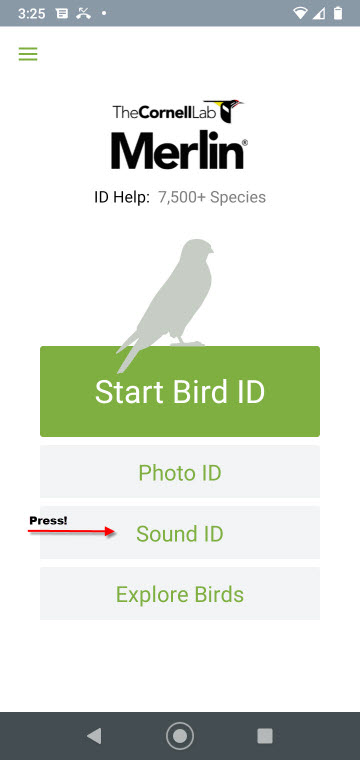By Jason Thiele
Wisconsin eBird Team
The Cornell Lab’s Merlin Bird ID app for smart phones is a game changer in the birding world, especially for its sound identification feature. But like any new technology, it’s not perfect, meaning eBirders should be careful not to report birds identified only by the app.
Birding, like virtually every other pastime, has been greatly influenced by advances in technology. Most advances in birding technology are simply updates to technology that’s been around for quite some time. Others are almost revolutionary when they first appear. For example, I would love to see the reaction that Alexander Wilson, John James Audubon and some of the pioneers of ornithology would have to seeing bird migration on radar.
One of the most recent “game changers” is sound recognition technology, which uses artificial intelligence to identify birds from recorded vocalizations. While there have been some computer programs and smart phone applications with these capabilities available for a few years, their popularity among birders was fairly limited because they were either expensive, unintuitive to use, or not really all that effective. About a year ago, however, with an update of its popular (and free) Merlin Bird ID app ( https://merlin.allaboutbirds.org/) the Cornell Lab of Ornithology introduced this technology to the masses. The app has exploded in popularity with birders of all skill levels.
As an eBird regional reviewer, I am wholly supportive of any means that birders can use to make accurate identifications and, especially, to provide solid documentation for rare, out-of-range, or out-of-season species. The more tools people have at their disposal to identify birds, the more confident they will feel in sharing their observations. Almost certainly, Merlin and other technological developments will help to increase our collective understanding of the distribution and movements of birds as more people make the jump from casual “bird watchers” to more intentional “birders” who report what they find.
However, birders can become overly reliant on Merlin or other apps for identifying birds. Over the past several months, the Wisconsin eBird team has noticed a substantial increase in “flagged” records, with many of them attributed to birds that were identified by their songs or calls using Merlin. While some of these reports were likely correct, they were not adequately documented, prompting reviewers to send out many follow-up e-mails to eBirders asking for more information.
Remember that whenever an observation in eBird is flagged for review (i.e., eBird prompts you to add comments when you submit your checklist), you should be providing details that allow a reviewer to be sure that you really encountered the bird/s you are reporting. It is important for all birders to understand that “heard only” records are especially difficult to scrutinize, regardless of whether you have help from your smart phone.
With that in mind, the Wisconsin eBird team suggests the following pointers and best practices for documenting birds identified using the Merlin app:
1. “Identified with Merlin” is not proper or acceptable documentation! Merlin can do a good job at identifying birds, but it’s not infallible. “Merlin said so” is really only slightly better than “My Uncle Bob, who is a very good birder, said that’s what it was.” You can (and probably should) mention that you used the app in your comments, but don’t stop there!
2. Save the recording of the bird to your device and upload it to your eBird checklist. An online tutorial is available at:
https://support.ebird.org/en/support/solutions/articles/48001185783-sound-id#Do-recordings-automatically-get-shared-with-Macaulay-Library?-Can-I-share-my-recordings-with-eBird-and-the-Macaulay-Library?%C2%A0
When you include a recording, it allows eBird reviewers to listen to the bird and to study the spectrogram of the recording and confirm or correct the ID. It also provides a much more robust record for posterity. Decades from now, ornithologists should have little to no doubt about the identity of a species in a “historical” record if a quality recording of its vocalizations has been saved.
3. If you’re unable to make or submit a quality recording, you should at the very least provide some sort of description of the song or call you heard. Again, these are very subjective and not nearly as valuable for documentation as a recording, but descriptive phrases like “a high-pitched, squeaky series of two notes” or comparisons to another species’ song like “similar to Red-eyed Vireo but raspier” or mnemonics like “teakettle, teakettle, teakettle” are much more helpful than “confirmed by Merlin” (see #1). Combined with other evidence (see #4), these notes may help to clinch an identification.
4. Whenever possible, offer other evidence such as a visual description of the bird, notes about its behavior, and/or a photograph or video to support the audio ID. Realize that some bird species sound very similar to others, some birds sing alternate songs that don’t match the “textbook” version, birds of the same species that live in different regions can have different dialects, and some birds can do very convincing imitations of other species’ vocalizations. Any of these scenarios can lead to misidentifications by Merlin or by birders (including eBird reviewers). More evidence is always better!
5. Above all, birding ethics should always apply. Don’t let your efforts to get a better recording (or a really great look or sharp photo) override the need to ensure that the bird is not disturbed from its activities. Pay close attention to the bird’s behavior in response to your presence; don’t chase it around. Be judicious in your use of playbacks to elicit a response from the bird, especially in highly-birded areas. Likewise, do not trespass onto private property to obtain better documentation. Review the Wisconsin Society for Ornithology Code of Ethics: https://wsobirds.org/about-wso/code-of-ethics
Merlin and similar apps are already boosting birders’ skills worldwide. That’s a good thing! For now, though, they should be used as tools that suggest a possible identification, not an ultimate confirmation. Please eBird accordingly.
The author thanks Ryan Brady and Nick Anich for providing comments and edits to improve the readability and content of this article.


